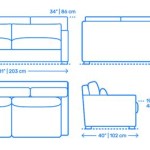The Evolution of the Sofa: A Journey Through Etymology and History
The sofa, a ubiquitous piece of furniture in modern homes, boasts a rich and multifaceted history. Its journey from ancient origins to its current form is intricately interwoven with cultural shifts, technological advancements, and evolving notions of comfort and status. Delving into the etymology of the word "sofa" itself reveals a fascinating connection to the Arabic world, while examining its historical development highlights the interplay between function and design that has shaped this iconic piece of furniture.
From Arabic Roots to European Adoption
The word "sofa" derives from the Arabic word "suffah," meaning "bench" or "platform." This term originally referred to a raised platform or dais, often found in the homes of wealthy Arabs, where they would sit and receive guests. Over time, the word "suffah" evolved into "soffa" and eventually "sofa" as it traveled westward, entering the vocabulary of European languages. The adoption of the term "sofa" into the English language can be traced back to the 17th century, during the age of exploration and burgeoning trade between Europe and the Ottoman Empire.
The introduction of the sofa to Europe coincided with a shift in architectural and social trends. The rise of grand, opulent interiors, characterized by ornate furniture and lavish decorations, provided a suitable setting for the imposing presence of a sofa. Initially, sofas were reserved for the elite, often featuring intricate carvings, luxurious fabrics, and elaborate upholstery. They served as symbols of wealth and status, reflecting the social hierarchies of the time.
From Status Symbol to Everyday Comfort
Throughout the 18th and 19th centuries, the sofa gradually transitioned from a symbol of luxury to a more accessible and practical piece of furniture. The Industrial Revolution and advancements in manufacturing techniques made sofas more affordable and available to a wider range of society. Designers began experimenting with different materials and styles, creating more versatile and comfortable designs. The emergence of the "chesterfield sofa" in the 18th century, with its distinctive tufted back and rolled arms, exemplifies this shift towards functional elegance.
The rise of the middle class in the 19th century further fueled the evolution of the sofa. As people sought comfortable and inviting spaces within their homes, the sofa became a key element in living rooms, bedrooms, and parlors. The advent of steam-powered machinery facilitated mass production, making sofas readily available to various socioeconomic groups. This widespread adoption led to a proliferation of styles, ranging from the grand and ornate to the minimalist and modern.
The Modern Sofa: Innovation and Versatility
The 20th century witnessed a dramatic transformation in the design and functionality of the sofa. The rise of modernism in architecture and design spurred innovative approaches to furniture construction. Furniture designers, like Le Corbusier and Mies van der Rohe, embraced simplicity, functionality, and clean lines in their designs, influencing the evolution of the sofa into a more minimalist and versatile piece.
The introduction of new materials, such as steel, foam, and synthetic fabrics, allowed for greater flexibility in shape and form. The emergence of modular sofas and sectional units added a new dimension to spatial arrangements, offering greater adaptability to different room configurations. Today, the sofa continues to evolve, seamlessly blending comfort, functionality, and style to meet the diverse needs and preferences of contemporary lifestyles.

A History Of The Sofa In 30 Seconds Sofasofa

The Origins Of Chesterfield Sofa Fleming Howland

Chesterfield Sofa Origin Name British Sofas

The Origin Of Sofa Hugues Chevalier

The Origin Of Sofa Hugues Chevalier

What Is A Chesterfield Sofa History

A History Of The Chesterfield Sofa British Design Classic Timeless Chesterfields

Couch Wikipedia

The Origin Of Sofa Hugues Chevalier

Sofa Who Invented It From Its Origins To The Present Day








